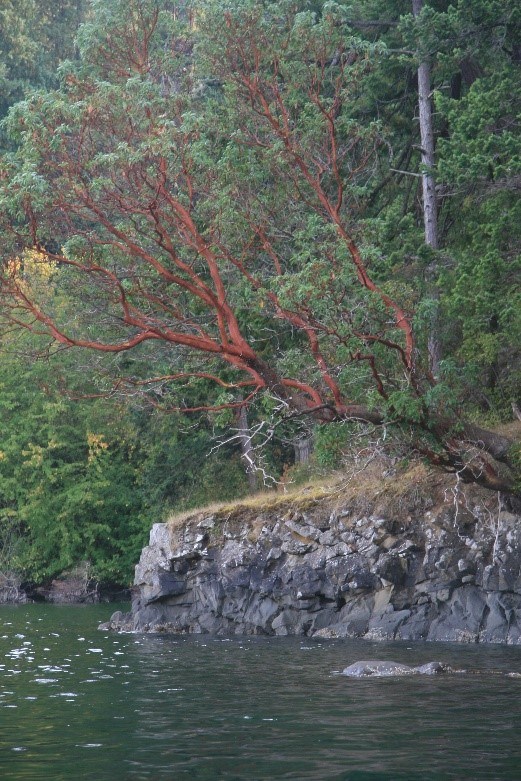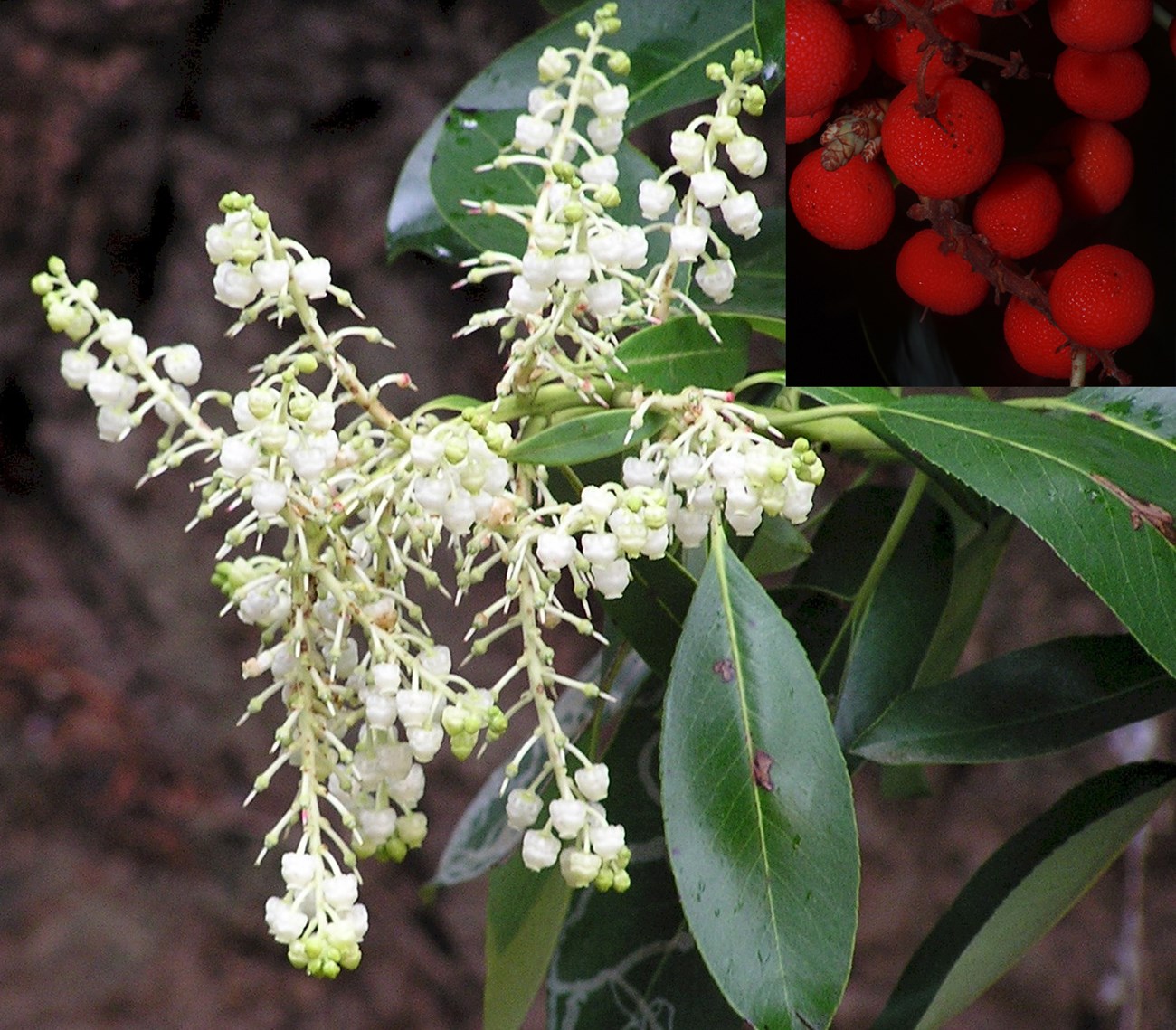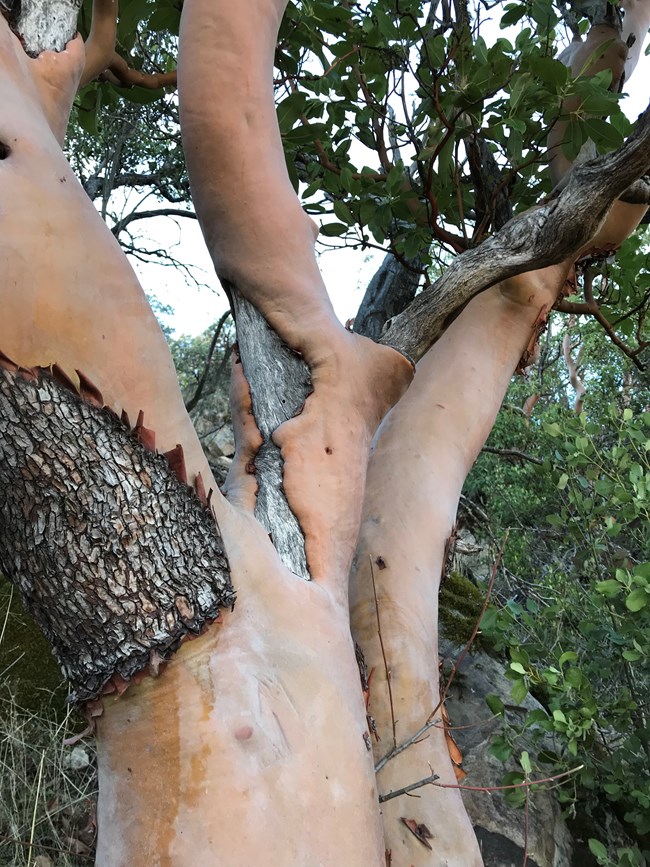Last updated: May 15, 2025
Article
Pacific Madrone

Arbutus_menziesii_jko10010800/jko/nwplants.com CC-BY-3.0.
General Description
Twisting skyward, the smooth, reddish-brown branches of a Pacific madrone tree are striking. Esteemed botanist, Willis Linn Jepson, described it as “a tree than which none other in the western woods is more marked by sylvan beauty.”
Arbutus menziesii, also called madroño, or the strawberry tree (for its berries), is an evergreen member of the heath family (Ericaceae), closely related to blueberries, mountain laurels, rhododendrons, and manzanita. Madrone trees can reach up to 40 m (130 ft), though more typically they are half that height. Its upper red-brown bark peels each summer in thin strips to reveal smooth, greenish-yellow bark that ripens into a deep, dark red color. White, fragrant, urn-shaped flowers (8 mm; 1/3 in) dangle in clusters at the ends of branches. Scarlet red, bumpy berries (8–12 mm) ripen in the fall and may last into early winter. Alternate, oval leaves (10–15 cm; 4–6 in long) are leathery and glossy dark green above and lighter grayish below. New leaves replace the old ones every two years before the old ones fall off.
Ecology
The Pacific madrone thrives in full sunlight and depends on periodic fire to create forest openings.
Birds, like robins, cedar waxwings, bandtailed pigeons, and quail eat its berries. Other berry-eaters include mule deer, raccoons, and bears. Woodpeckers and other cavity nesting birds, like mountain chickadees, house wrens, and western bluebirds nest in madrones.

Arbutus_menziesii_jen0927053/jen/nwplants.com CC-BY-3.0. Inset: NPS/John Roth
Reproduction
The Pacific madrone reproduces vegetatively more than by seed. After a disturbance, like fire, burls at the base of the tree produce root crown sprouts, forming a multi-trunked tree. Bees and possibly hummingbirds pollinate its flowers.

NPS/Sonya Daw
Habitat and Distribution
Madrones occur natively in the Pacific Northwest from the coast ranges of southern California north into British Columbia. Some populations grow at middle elevations in the Sierra Nevada. They are relicts of the drought-resistant Madro-Tertiary geoflora that once occupied the Pacific Northwest millions of years ago. Madrones are common in coastal mixed forest. They flourish in dry, well-drained soils with gaps in the canopy for access to sunlight.
Ethnobotany
Native American tribes of the Pacific Northwest had multiple uses for this tree. Though not sweet, its berries made cider. They were also strung for necklaces and used as bait for steelhead fishing. Its bark made a medicinal tea to wash sores and treat colds and sore throats. Chewing its leaves treated cramps and stomachaches.
Conservation
Fire suppression is a conservation concern for madrones because it has allowed shade tolerant species to overgrow and compete with madrone.
Where to See
Look for madrones in Crater Lake National Park, Oregon Caves National Monument and Preserve, Redwood National and State Parks, and Whiskeytown National Recreation Area.
More Information
https://oregonencyclopedia.org/articles/pacific_madrone/#.Wqmysejwa70
https://plants.usda.gov/plantguide/pdf/cs_arme.pdf
Download a pdf of this article.
Prepared by Sonya Daw
NPS Klamath Inventory & Monitoring Network
Southern Oregon University
1250 Siskiyou Blvd
Ashland, OR 97520
Featured Creature Edition: March 2018
